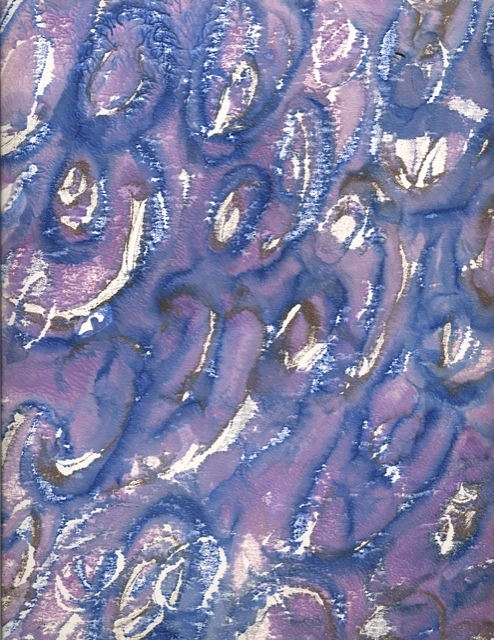
Cat Crotchett is a visual artist and professor at Western Michigan University. She recently sat down with Bradley Rubenstein in Chelsea to talk about her new work.
Bradley Rubenstein: It was great seeing some of your new pieces. I’m not sure exactly what we should call them -- they are a kind of hybrid print. I was comparing them to the two little Pollocks up at the Whitney now [Untitled (1939-42); Untitled (1944)] where he was also using wax as part of the process. Can we talk a little about your new pieces first?
Cat Crotchett: They are encaustic mono-prints and involve a very intuitive process based on random marks I make with the encaustic paint when I’m printing. At this point I can’t predict how they’ll look when they transfer to paper. When I look at the paint on the encaustic palette, I have an idea of how the piece might turn out, but the reality is something completely different. I’ve decided to embrace this abdication of control even though it is definitely uncomfortable.
BR: You were just over at MoMA; it was interesting listening to you talking about the Boetti show. You used the word “modular” in describing a lot of what you liked. Kind of a unifying theme. Your paintings definitely share that element; they are a kind of “modular-composite” type of art making.
CC: Yes, that just happened as my work progressed. I went to Indonesia in 2009 and came back with some traditional batik caps. I had also written a grant to go there in which I talked about combining encaustic painting with batik tools. So, my work prior to this had involved figurative elements overlaid with patterns and abstract shapes of light. When I started experimenting with batik tools, I realized I’d have to try something different. It seemed natural to work on a smaller scale where the Indonesian cap pattern could easily fill the composition. After completing several of these, I liked the way they looked together and got the idea to make a large piece out of many smaller ones. This piece has now taken on a life of its own; when it’s shown, the curator determines what form it takes and how the individual components relate to each other. I’ve also made the nature of this piece organic -- meaning panels can be added to it or subtracted from it based on the nature of the exhibition or the pieces that are available. Once I made one modular work, I began seeing everything in units that could be put together in different ways. After years of making individual pieces, this just makes more sense to me right now as part of my visual language.
BR: I like the organic nature of the encaustics you are using, not just in the sense that wax is organic, but that the encaustic has a kind of “life” as a painting material. The wax is liquid and mutable while it is hot, then as it cools you only have a certain amount of time before it transforms into a solid, sculptural material. You use this process within this geometrical, Baroque framework, juxtaposing the pliability of the wax within the structure, which is almost like a mathematical “given” to the equation. How does this work for you? Is this what you have in mind going into the pieces, or is your method more intuitive?
CC: It really depends on the piece. I did a series of pieces based on traditional Italian patterns, and those required a clear structure as part of the process because I was interested in a particular outcome. Part of the process involved the use of stencils and layers of wax, so in that sense the final piece was more a of given. However, when painting with wax only so much can be predicted, which is part of what makes it such an attractive material to work with.
In contrast, my current work using batik caps is unpredictable. I can have an idea of what layers of colors I’ll use and what I hope to see in the final piece, but the method is much more intuitive. The wax is hot, the batik cap is hot, and so much is dependent on the heat of those components, the pressure I apply to the cap, etc. So every step of the way there are variables with only so much room for prediction. Once I stamp the piece with the hot cap I have to be prepared to respond as a painter to a problem that I’ve just created for myself to solve. It definitely keeps things interesting.
BR: Going way back, you were interested in Kandinsky -- and, by the way, your interest in his work and writings had a great impact on my looking at Kandinsky. Looking at your work now, do you still have any affinities with his work, or theories, or do you think that connection is minimized? I wonder sometimes if there are any works or artists that one stays with over the years, that keep having an influence on one’s work.
CC: That’s an interesting question. To be honest, I haven’t thought about Kandinsky, other than in an academic way, for years! I’ve been a figurative painter for most of my career and would be confident saying that his work definitely influenced my sense of color. Now that my work is abstract, it would be interesting to revisit his work as a visual artist, thinking about process and theory.
